The sky over North Carolina is a stage for the grand performance of many winged wonders. Among them, the largest flying birds steal the spotlight with their impressive wingspans and graceful maneuvers. They are a testament to nature’s incredible ability to engineer flight on a large scale. This article will introduce you to some of the largest flying birds that grace the skies of North Carolina. With each flap of their wings, they tell a story of a world where sheer size and graceful flight come together in a single beautiful display. Get ready to meet these avian giants and learn about their lives in the Tar Heel State!
1. American White Pelican (Pelecanus erythrorhynchos) – Wingspan: 7′ 11″ to 10′
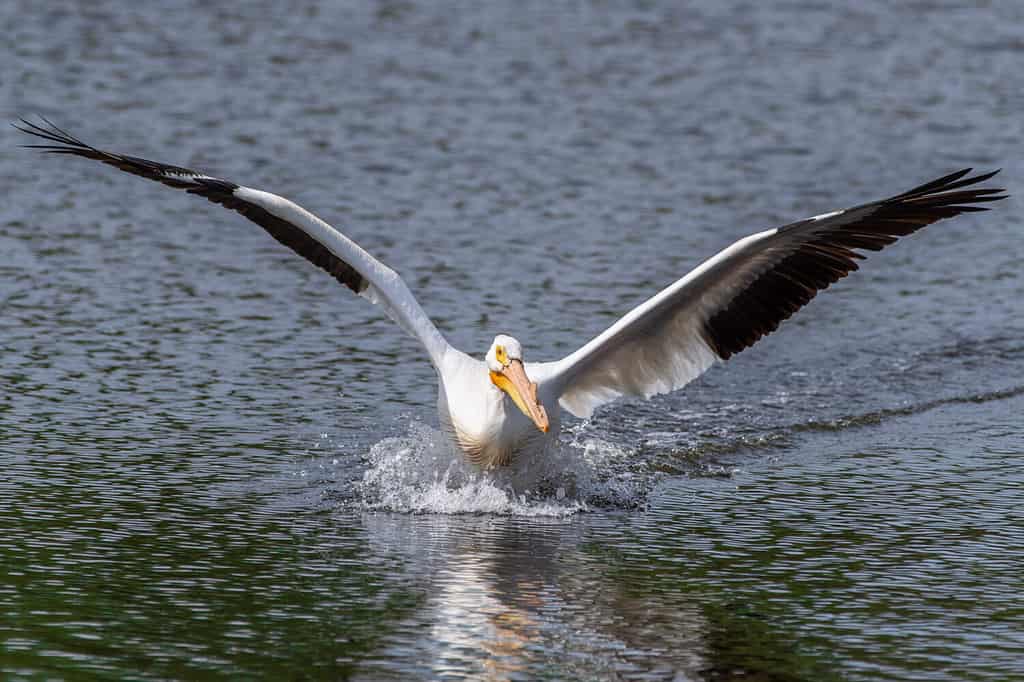
The largest flying bird in North Carolina is the American white pelican.
©Mike Lynds/Shutterstock.com
During the winter months, you can see the magnificent American white pelican in North Carolina near both the ocean and freshwater bodies.
Length: 50 inches to 70 inches
Wingspan: 95 inches to 120 inches
This bird holds the title of being the largest bird that can fly in North Carolina. Only the California condor beats it in the entirety of North America when it comes to the average wingspan. While American white pelicans may appear clumsy when they’re walking on land, these pelicans are surprisingly agile when flying or swimming.
These large water birds are distinguished by their expansive wings, elongated necks, and oversized bills that create a uniquely long head shape. Their physique is robust, supported by short legs and a stubby, squared-off tail.
They’re found in environments like lakes, wetlands, and salty bays. Their diet mainly consists of types of fish that people don’t commonly consume, and they also eat crayfish and salamanders.
2. Magnificent Frigatebird (Fregata magnificens) – Wingspan: 7′ 1″ to 8′
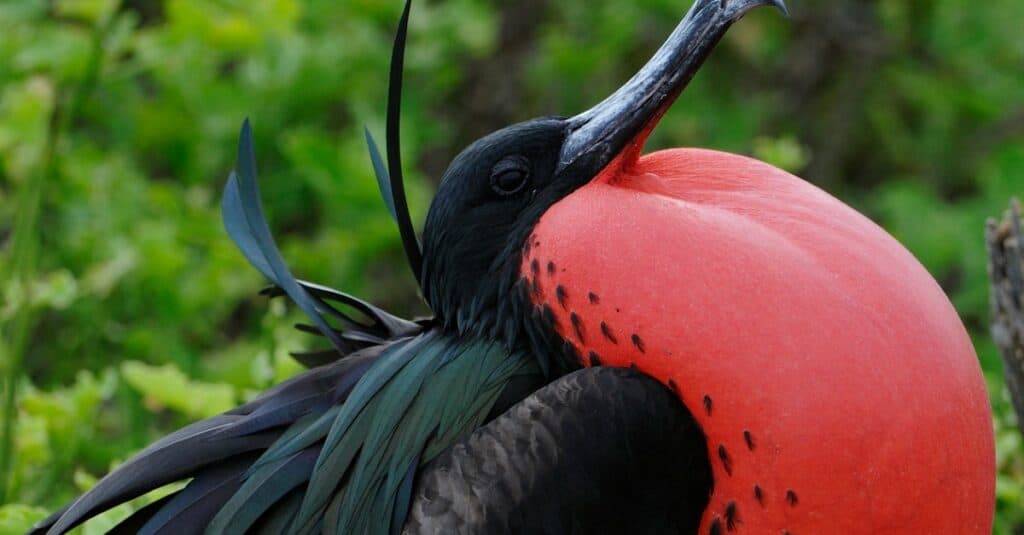
In the breeding season, the magnificent frigatebird male will puff out its red throat as pictured above.
©iStock.com/Clay Clark
In the summer, you can spot magnificent frigatebirds along North Carolina’s shoreline. It’s the state’s second-biggest bird capable of flight.
Length: 35 inches to 45 inches
Wingspan: 85 inches to 96 inches
The magnificent frigatebird is a sizable, all-black bird. It has a long, gray beak that ends in a hook. The tail resembles a pair of scissors due to its deep fork, and its wings are sharply pointed. During courtship, males display red throat sacs, which they inflate to catch the attention of female birds.
You’ll generally find these birds in warm coastal and island areas. As for their diet, magnificent frigatebirds mainly consume flying fish, tuna, herring, and squid. They have a knack for snatching food from the water’s surface without getting drenched.
3. Bald Eagle (Haliaeetus leucocephalus) – Wingspan: 6′ 7″ to 8′

Of course, it comes as absolutely no surprise that the bald eagle is one of the largest flying birds in North Carolina.
©PHOTOOBJECT/Shutterstock.com
Bald eagles are a common sight at Falls Lake and Jordan Lake in the Piedmont and Lake Mattamuskeet in Hyde County.
Length: 36 inches to 43 inches
Wingspan: 79 inches to 96 inches
The adults, whether male or female, have brown bodies but are easily identifiable by their white heads, necks, and tails. Their eye color is a pale yellow, matching their beaks and claws.
These majestic birds favor environments with lakes or reservoirs, often close to forested regions. Their favorite food is fish. As some of the largest flying predators, they can ascend to heights of up to 10,000 feet.
4. Trumpeter Swan (Cygnus buccinator) – Wingspan: 7′ 11″
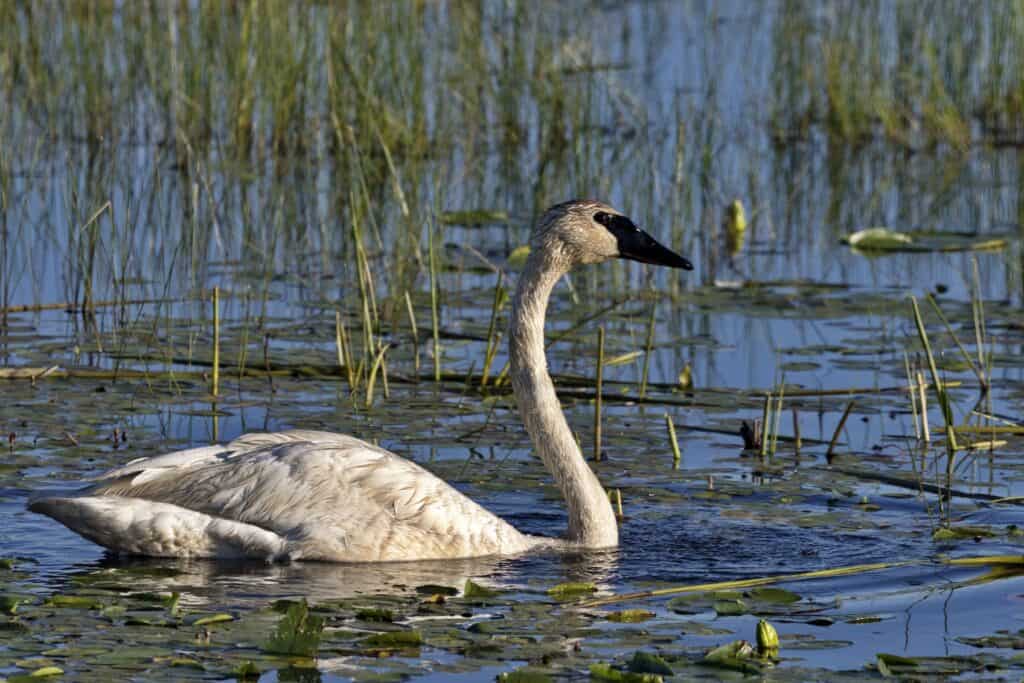
The trumpeter swan is one of the largest flying birds in the state and boasts a wingspan of 95 inches or almost 8 feet!
©Florence-Joseph McGinn/Shutterstock.com
In North Carolina, spotting a trumpeter swan is quite a rare event, as these birds are not commonly found in the state.
Length: 45 inches
Wingspan: 95 inches
Fully grown trumpeter swans are all white, featuring a black bill and legs. Younger swans are grayish-brown in color. These birds often feed in shallow waters, diving or tipping forward to snack on underwater plants, much like dabbling ducks do.
Preferred habitats for these swans are quite diverse, including waterside woodlands, lakes, marshes, ponds, and even open prairies. While they mainly consume aquatic plants, they occasionally indulge in fish and fish eggs.
As the largest swan species, trumpeter swans also rank among the largest flying birds globally.
5. Mute Swan (Cygnus olor) – Wingspan: 6′ 10″ to 7′ 10″
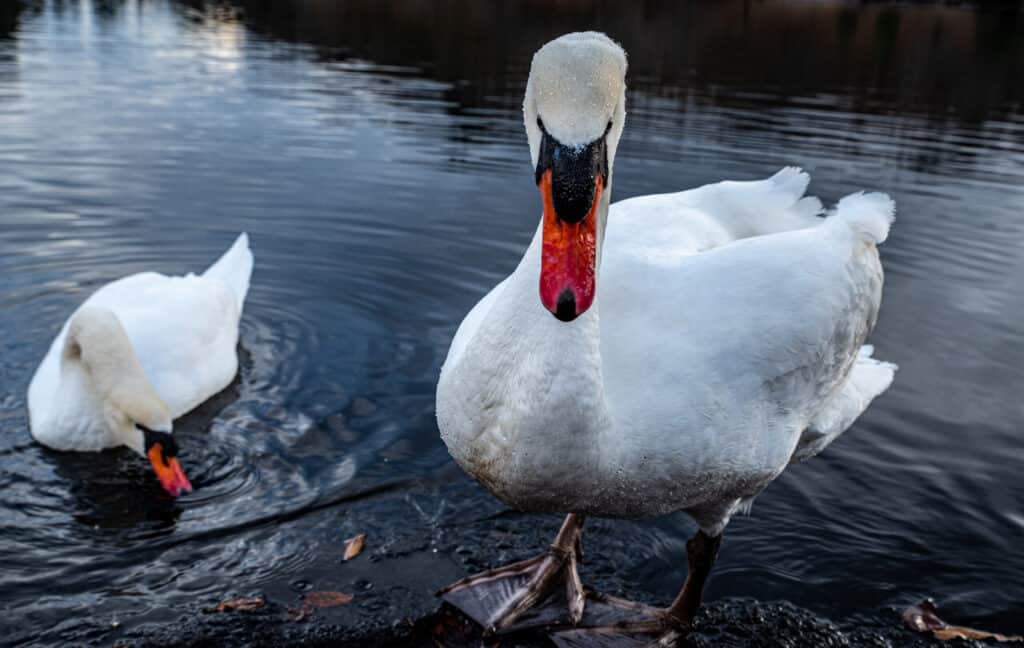
Another swam that makes this list of the largest flying birds in North Carolina is the mute swan.
©TETSU Snowdrop/Shutterstock.com
Mute swans are mostly year-round residents and can be spotted in various parts of North Carolina.
Length: 50 to 60 inches
Wingspan: 82 to 94 inches
These swans are all white and have an orange bill with a black base. Young mute swans, known as cygnets, are often a shade of brownish-gray and have a gray-black bill.
Mute swans prefer water-rich areas like bays, rivers, wetlands, and the shallow parts of lakes and ponds that have plenty of underwater plants. Their diet mainly consists of plant-based foods like seeds, leaves, and roots of water plants, but they’ll also eat insects, small fish, and snails on occasion.
6. Black-Browed Albatross (Thalassarche melanophris) – Wingspan: 6′ 7″ to 7′ 10″
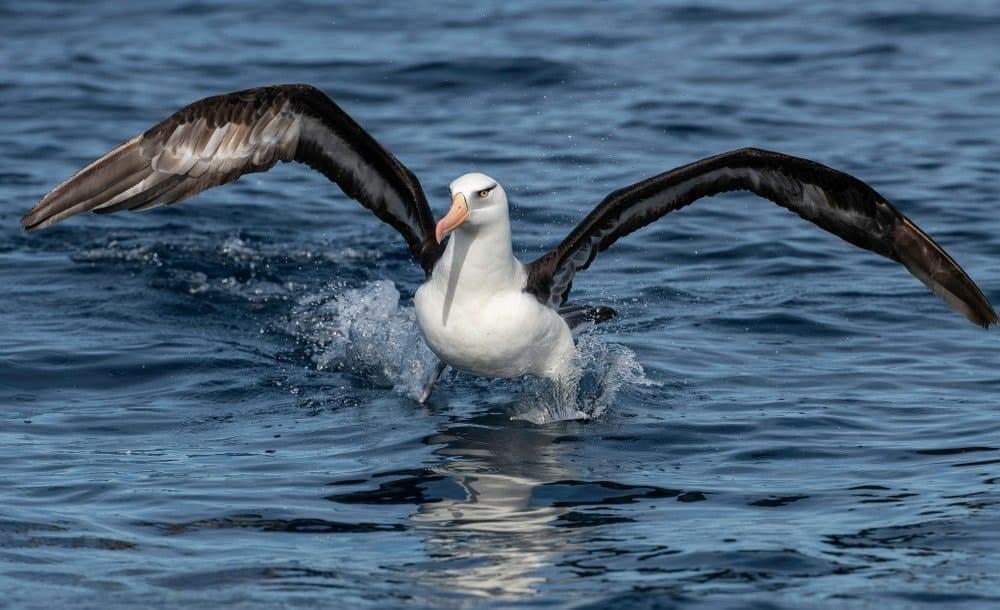
The black-browed albatross is not a common species in North Carolina, but you may be able to spot one if you’re lucky.
©wildestanimal/Shutterstock.com
Spotting a black-browed albatross in North Carolina is quite a rare occurrence, so consider yourself lucky if you do see one.
Length: 31 to 37 inches
Wingspan: 79 to 94 inches
These birds have mostly white underwings with irregular black edges, a dark brow, and a yellow-orange beak that has a darker orange tip.
They spend most of their lives at sea, coming ashore only for breeding. When it comes to eating, they usually fly close to the water surface to catch food like krill and fish, but they also consume jellyfish and squid on occasion.
7. Great Blue Heron (Ardea herodias) – Wingspan: 7′

A relatively common bird in North Carolina, the great blue heron has a wingspan of 84 inches.
©flownaksala/iStock via Getty Images
Great blue herons are present throughout the year in North Carolina, especially in the regions of the Coastal Plain and Piedmont.
Length: 50 inches
Wingspan: 84 inches
These are the largest herons in North America, easily recognizable by their elongated legs, winding neck, and pointed beak. Of course, their blue-gray feathers are their signature look. In flight, they tuck their necks into a distinct ‘S’ curve, their wings appear wide, and their legs stretch out beyond their tails.
They adapt well to various environments, whether it’s freshwater or coastal areas. Primarily, they like to feast on sizable fish they can catch.
8. Brown Pelican (Pelecanus occidentalis) – Wingspan: 6’ to 7′
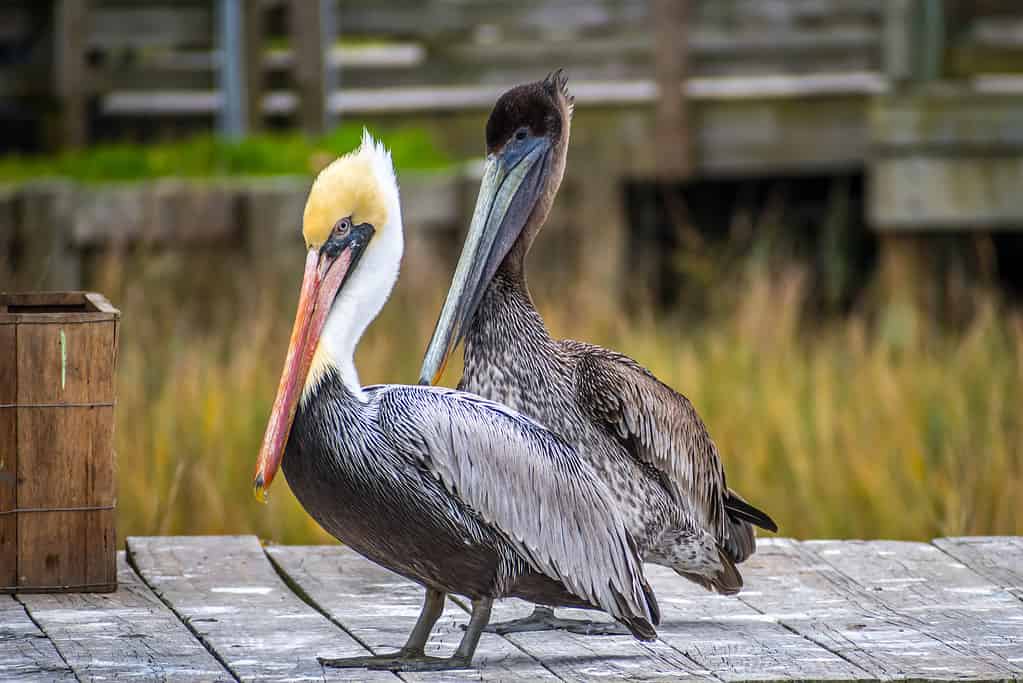
Brown pelicans don’t generally stay in North Carolina all year, but some individuals may, despite the colder weather.
©Cheri Alguire/iStock via Getty Images
In North Carolina, you’ll find a few brown pelicans sticking around all year, although extremely cold weather can cause frostbite on their webbed feet and pouches.
Length: 48 inches
Wingspan: 84 inches
These large birds are mostly gray-brown and have a unique, pouched beak. When it’s time to mate, their head feathers turn a vivid yellow, and their necks go white, but these colors fade to more muted tones when they’re not breeding.
These birds are commonly found near coastal beaches and lagoons, where they feed on medium-sized fish and some small sea creatures, needing about four pounds of food each day. Brown pelicans are the only species known for their dramatic dives from heights of 30 to 60 feet to catch their prey.
9. Sandhill Crane (Antigone canadensis) – Wingspan: 6′ 8″

One of the largest flying birds you’ll see in marshy areas of the state is the sandhill crane.
©Benjamin Tillotson/Shutterstock.com
Spotting a sandhill crane in North Carolina is rare and unpredictable.
Length: 37 inches
Wingspan: 80 inches
These birds have a grayish color, often tinged with a rusty shade on their backs. Adult cranes have lighter cheeks and red skin on top of their heads, while younger birds lack these features and are mostly gray and brown.
These cranes usually reside in marshes, grassy wetlands, and river valleys. Their diet is diverse, ranging from insects and plant roots to small animals like rodents, frogs, and even young birds, as well as various fruits and seeds.
10. Golden Eagle (Aquila chrysaetos) – Wingspan: 6′ 6″
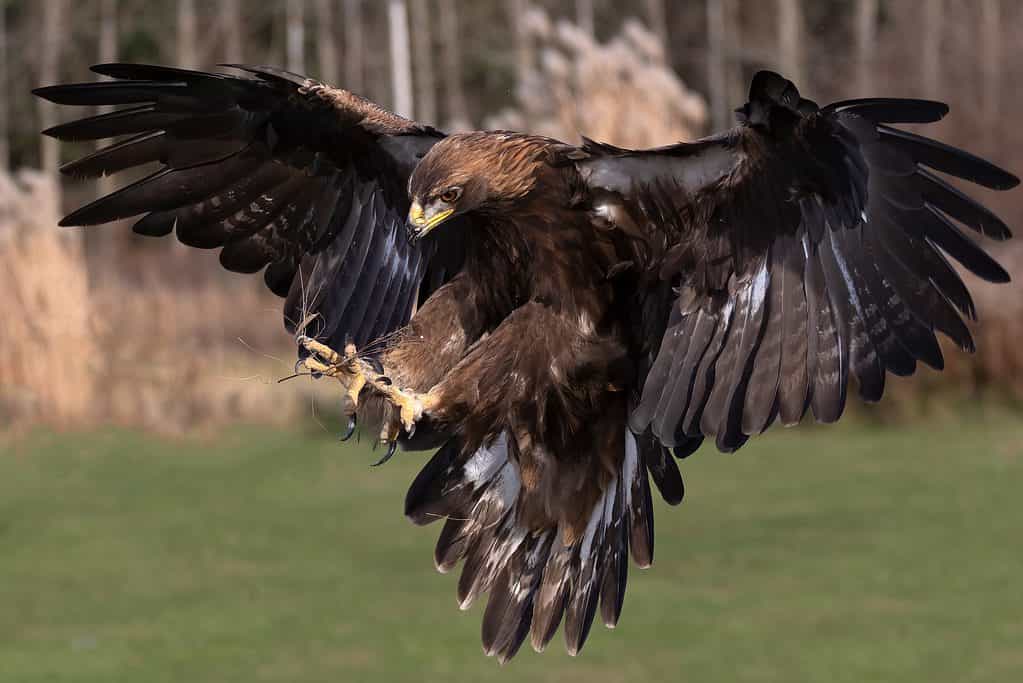
The golden eagle is a huge bird with an impressive wingspan of 78 inches or 6 feet and 6 inches.
©Touched by light images/Shutterstock.com
In North Carolina, golden eagles favor secluded mountain regions for their nests, where they have both safety and a wide view.
Length: 27 to 33 inches
Wingspan: 78 inches
These eagles have dark brown feathers, with a touch of white at the tail base and gold-colored feathers on the back of their heads. Their beaks and claws are black. Younger golden eagles have a wide white stripe on their tails and big white spots under their wings.
These birds prefer habitats like open mountains, hills, and plains. In terms of diet, golden eagles mainly eat small mammals like mice, jackrabbits, and prairie dogs, but they can also consume other birds, reptiles, fish, and large insects.
11. Canada Goose (Branta canadensis) – Wingspan: 6′ 3″
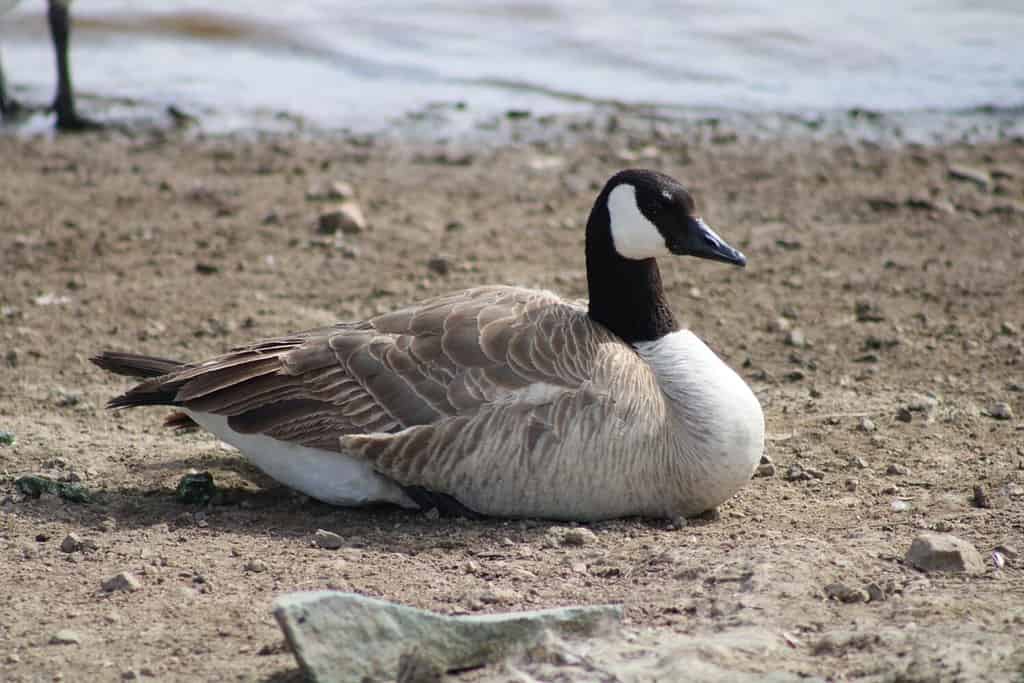
A common waterfowl in North Carolina, the Canada goose has a black head and neck, with a white stripe on its chin.
©Charlotte Evelyn/Shutterstock.com
The Canada goose is one of the most familiar waterfowl in North Carolina.
Length: 25 to 45 inches
Wingspan: 75 inches
This large bird has a black head and neck, set apart by a unique white stripe below the chin. Its back and wings are a shade of brownish-gray, while its breast and sides are lighter in color.
For nesting, the Canada goose chooses a range of wetlands like icy tundras, freshwater marshes, and wooded lakes. It often grazes in open spaces, mainly during winter. Though plants make up most of their diet, these birds occasionally eat insects, shellfish, and even small fish.
12. Turkey Vulture (Cathartes aura) – Wingspan: 6’
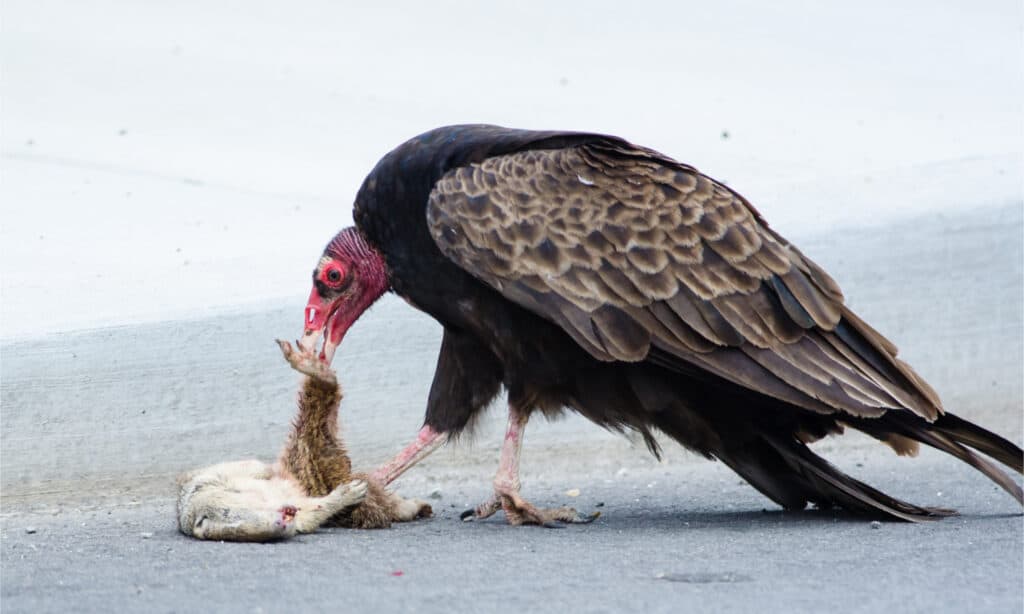
The turkey vulture is one of the largest flying birds in North Carolina, boasting a wingspan of 6 feet.
©hubert999/Shutterstock.com
One of North Carolina’s biggest vultures is the turkey vulture.
Length: 32 inches
Wingspan: 72 inches
From afar, these birds look black, but up close, they’re dark brown with a bald red head and a light-colored beak. The undersides of their wings have a lighter shade, giving them a two-tone look.
Turkey vultures are found in both open and wooded areas but usually steer clear of cities and suburbs. Their diet consists mainly of dead animals and human garbage.
Turkey vultures can cover up to 200 miles in a single day. Though their feet aren’t capable of killing, their beaks are strong enough to tear through tough animal skin.
13. Osprey (Pandion haliaetus) – Wingspan: 4′ 2″ to 5′ 11″
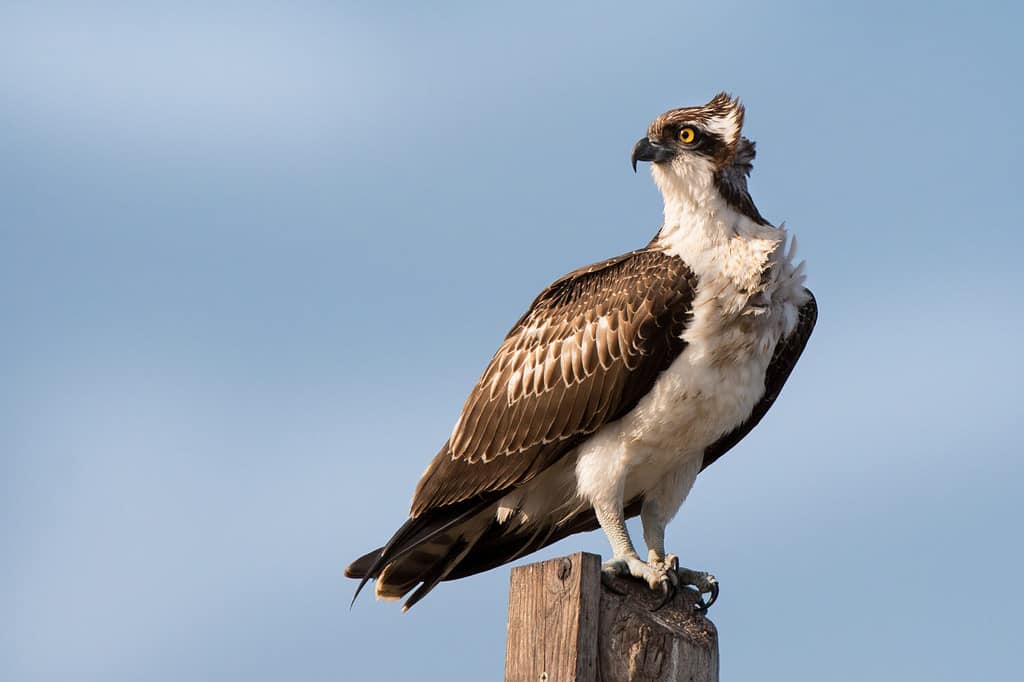
The osprey is a bird of prey that feeds on fish; it boasts a wingspan ranging from 50 to 71 inches.
©Jesus_Miguel/Shutterstock.com
Another one of the largest birds you’ll often see flying in North Carolina is the osprey.
Length: 20 to 26 inches
Wingspan: 50 to 71 inches
This bird of prey primarily feeds on fish. It has a white head marked by a unique brown line across its eyes. Both males and females have white undersides and brown upper bodies, though females often have an extra brown spot on their chests. While adults have yellow eyes, the younger ospreys have orange eyes.
In North Carolina, ospreys are common in coastal areas during spring and summer, nesting near bodies of water like estuaries, lakes, and rivers. They’re also spotted inland, close to mountainous lakes and rivers.
Interestingly, ospreys are found on every continent except for Antarctica.
14. Great Black-Backed Gull (Larus marinus) – Wingspan: 4′ 11″ to 5′ 7″
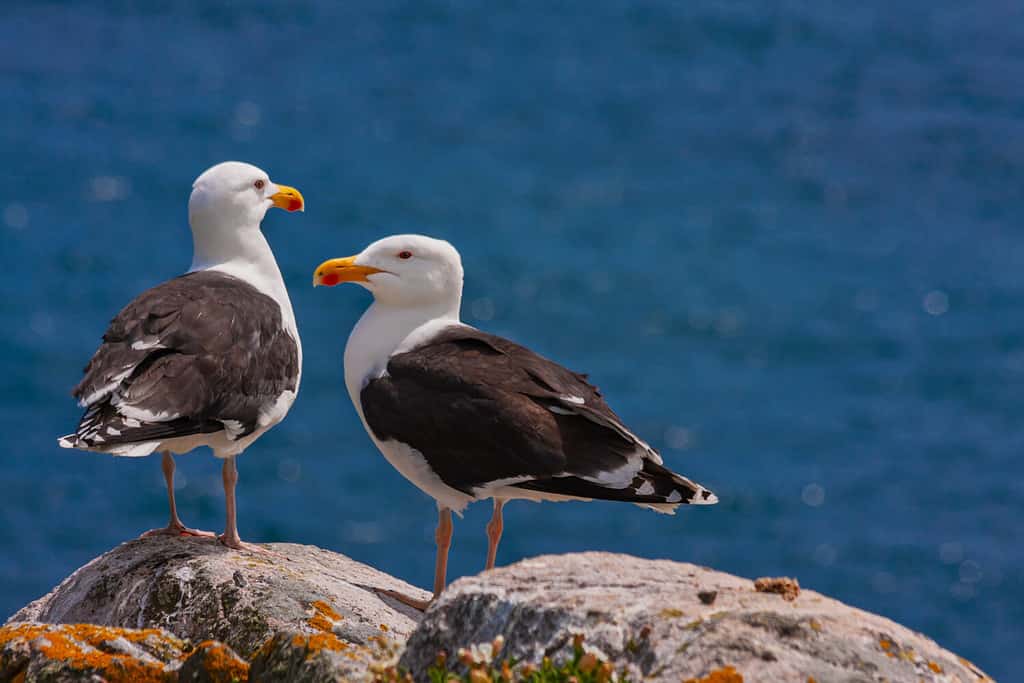
The largest gull species in the world is the great black-backed gull, which can be found along the Atlantic coast of North Carolina.
©Nicola_K_photos/Shutterstock.com
In North Carolina, you’ll find great black-backed gulls all year, but only along the Atlantic coast. Their large size makes them easy to spot.
Length: 25 to 31 inches
Wingspan: 57 to 67 inches
This is a big, robust gull with wide wings, a thick neck, and a somewhat rounded bill. Adults have dark gray, almost black upper bodies and white heads and bellies. They also have pink legs.
For nesting, they pick secluded, safe spots like piers or islands. After the breeding season, they scatter to find food at sea, along shorelines, or in garbage dumps. Their diet is varied, including dead animals, fish, shellfish, sea worms, bugs, small mammals, and even other birds’ eggs and young.
It’s worth noting that the great black-backed gull is the largest gull species in the world.
15. Black Vulture (Coragyps atratus) – Wingspan: 4′ 4″ to 5′ 6″
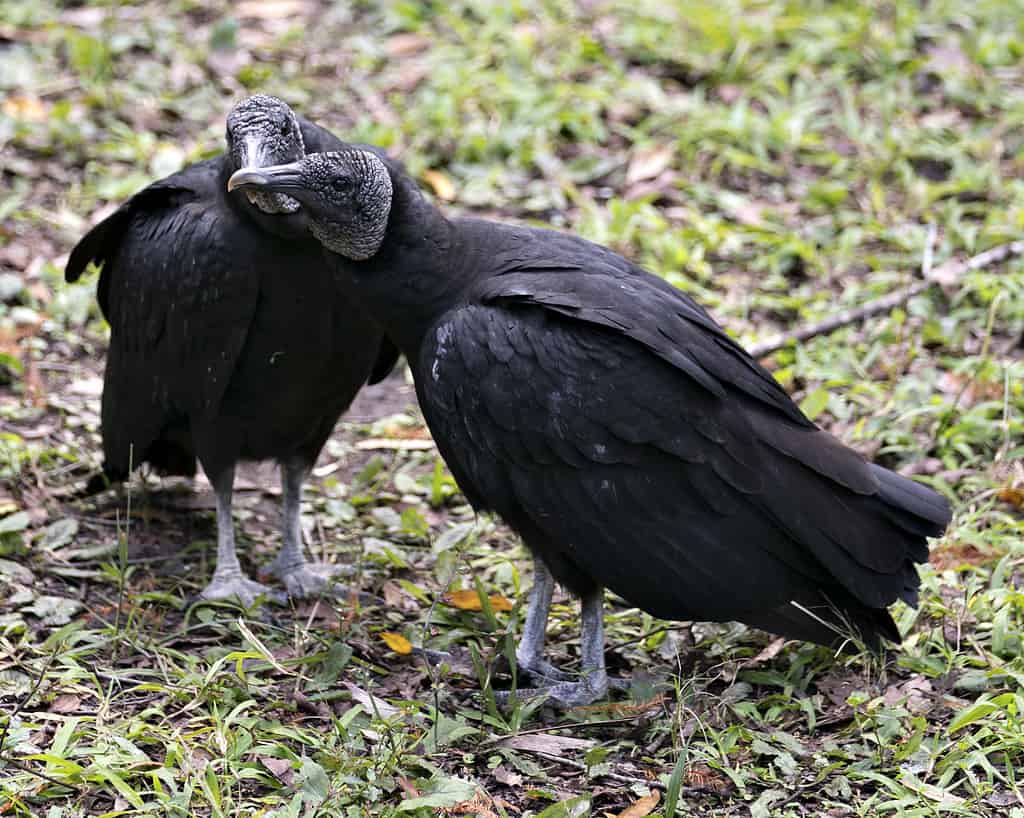
Just slightly smaller than the turkey vulture, the black vulture is one of the largest flying birds in North Carolina.
©iStock.com/Rejean Bedard
In North Carolina, black vultures aren’t common but can be seen occasionally.
Length: 22 to 29 inches
Wingspan: 52 to 66 inches
Black vultures are sleek birds with all-black feathers, a featherless black head, and unique white spots under their wingtips. Unlike the longer and more uneven flight of turkey vultures, black vultures fly with strong, steady wingbeats and have shorter tails.
They usually hang out in open or semi-wooded areas, often near human communities. Their main diet consists of large animal carcasses, preferring the fresh ones, but they’ll also eat meat that’s started to decay.
When it comes to feeding, black vultures are usually seen in big groups. They’re so aggressive when eating that other types of vultures typically keep their distance.
16. Wood Stork (Mycteria americana) – Wingspan: 5′ to 5′ 5″
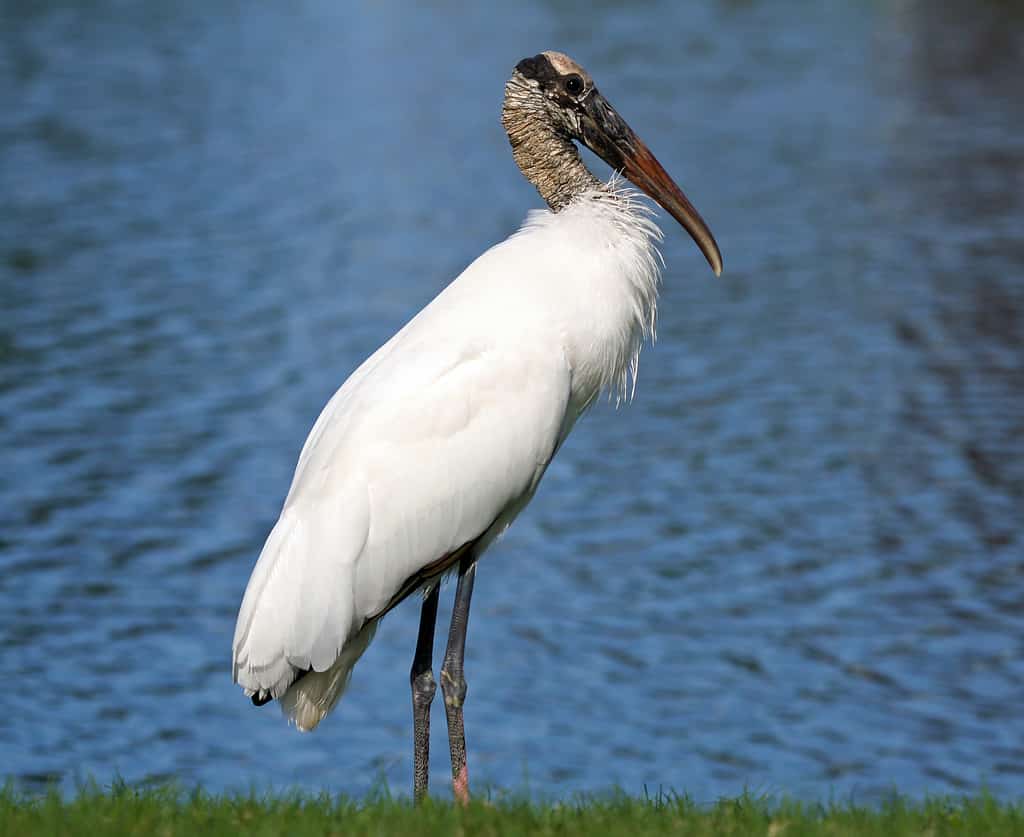
A protected species, the wood stork is the only stork in North America and boasts a wingspan of up to 65 inches.
© Googie man at en.wikipedia / CC BY-SA 3.0 – License
The wood stork is unique in North Carolina for being one of the largest waterbirds and a federally protected species.
Length: 35 to 45 inches
Wingspan: 60 to 65 inches
The wood stork is the only stork species that breeds in North America and can be identified by its bare gray-to-black neck and head, contrasting with a white body and black-tipped tail and wings. The bird also has a long, slightly curved black bill and extended legs.
These birds prefer to breed in both fresh and slightly salty forested wetlands. Their diverse diet includes everything from fish and frogs to large insects and occasionally even small rodents.
17. American Flamingo (Phoenicopterus ruber) – Wingspan: 4′ 3″ to 5′ 5″
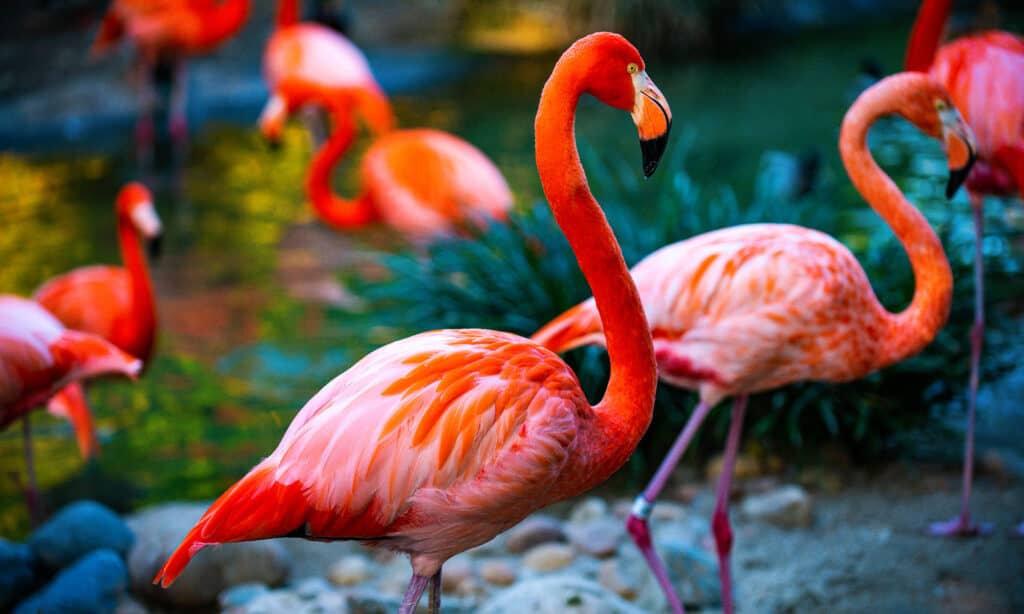
American flamingoes make the list of the biggest flying birds in the state, as they are tall and have a wide wingspan.
©Volodymyr TVERDOKHLIB/Shutterstock.com
The last bird on the list of largest flying birds in North Carolina is the American flamingo. It is a rare species in the state and is hard to find.
Length: 47 to 57 inches
Wingspan: 51 to 65 inches
The American flamingo stands out with its pink plumage and wings that have black tips. It features an elongated neck, long pink legs, and webbed feet with three toes. Its large bill is curved downward and ends in a black tip.
Typically found in shallow saltwater or brackish bodies of water, as well as alkaline lakes, these flamingos munch on algae, tiny seeds, and water-dwelling critters like brine shrimp and small shellfish.
18. Great Horned Owl (Bubo virginianus) – Wingspan: 4′ 6″
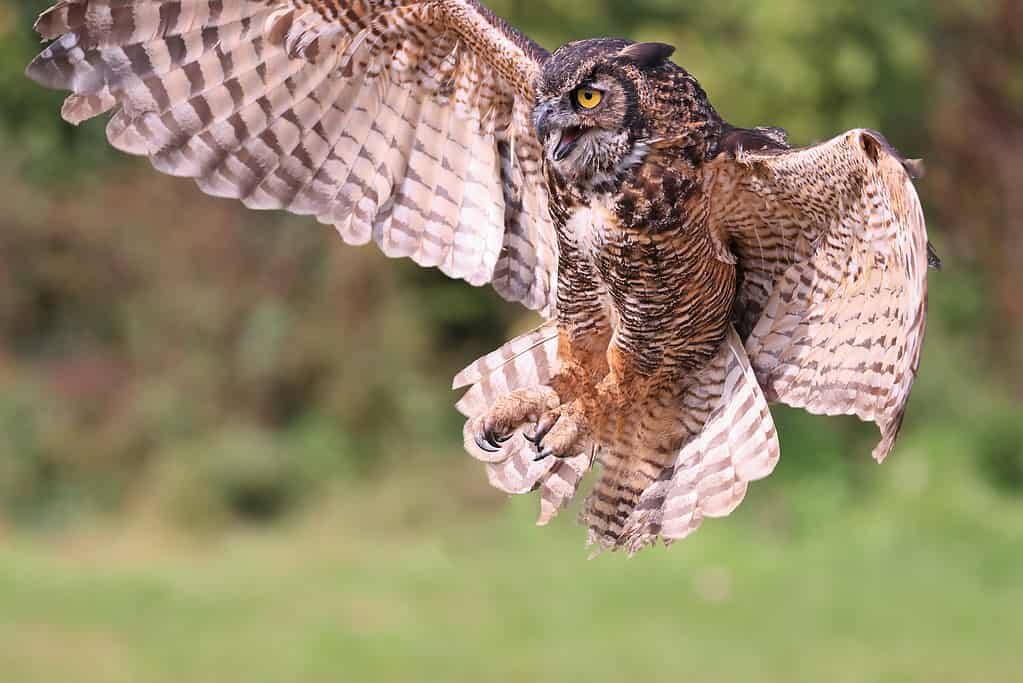
An honorable mention, the great horned owl is the largest flying owl in North Carolina.
©Vladone/iStock via Getty Images
The great horned owl is often spotted in North Carolina.
Length: 24 inches
Wingspan: 54 inches
This owl is sizable, with two noticeable tufts of feathers on its head. It has gray and brown feathers, a face tinged with reddish-brown, and bright yellow eyes. Its wings and tail feature alternating light and dark stripes. Its throat lightens and expands when it makes a call.
The great horned owl is found in wooded areas, beside streams, and in open spaces. Though it favors eating mammals, it also hunts birds, reptiles, bugs, fish, and other sea creatures. It even eats dead animals and scorpions. When food is scarce, it eats whatever is accessible.
Summary of the Largest Flying Birds in North Carolina
| Rank | Bird | Length | Wingspan |
|---|---|---|---|
| 1. | American White Pelican | 4′ 2″ to 5′ 10″ | 7′ 11″ to 10′ |
| 2. | Magnificent Frigatebird | 2′ 11″ to 3′ 9″ | 7′ 1″ to 8′ |
| 3. | Bald Eagle | 3′ to 3′ 7″ | 6′ 7″ to 8′ |
| 4. | Trumpeter Swan | 3′ 9″ | 7′ 11″ |
| 5. | Mute Swan | 4′ 2″ to 5′ | 6′ 10″ to 7′ 10″ |
| 6. | Black-Browed Albatross | 2′ 7″ to 3′ 1″ | 6′ 7″ to 7′ 10″ |
| 7. | Great Blue Heron | 4′ 2″ | 7′ |
| 8. | Brown Pelican | 4′ | 6’ to 7′ |
| 9. | Sandhill Crane | 3′ 1″ | 6′ 8″ |
| 10. | Golden Eagle | 2′ 3″ to 2′ 9″ | 6′ 6″ |
| 11. | Canada Goose | 2′ 1″ to 3′ 9″ | 6′ 3″ |
| 12. | Turkey Vulture | 2′ 8″ | 6’ |
| 13. | Osprey | 1′ 8″ to 2′ 2″ | 4′ 2″ to 5′ 11″ |
| 14. | Great Black-Backed Gull | 2′ 1″ to 2′ 7″ | 4′ 11″ to 5′ 7″ |
| 15. | Black Vulture | 1′ 10″ to 2′ 5″ | 4′ 4″ to 5′ 6″ |
| 16. | Wood Stork | 2′ 11″ to 3′ 9″ | 5′ to 5′ 5″ |
| 17. | American Flamingo | 3′ 11″ to 4′ 9″ | 4′ 3″ to 5′ 5″ |
| 18. | Great Horned Owl | 2′ | 4’ 6” |
The photo featured at the top of this post is © PHOTOOBJECT/Shutterstock.com
Thank you for reading! Have some feedback for us? Contact the AZ Animals editorial team.






